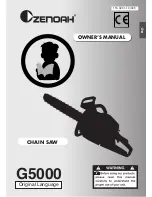
50
EN
escape path should extend back and diagonally to the rear of the expected line of fall as
illustrated in fig.F.
F= Felling direction
D = Danger zone
E= Escape route
• Before felling is started, consider the natural lean of the tree, the location of larger
branches and the wind direction to judge which way the tree will fall.
• Remove dirt ,stones, loose bark, nails, staples and wire from the tree and the area
around.
Notching undercut
Make the notch 1/3 the diameter of the tree. Perpendicular to the direction of falls as
illustrated in fig.G. Make the lower horizontal notching cut first. This will help to avoid
pinching either the saw chain or the guide bar when the second notch is being made.
D= Direction of fall
F= Felling back cut
N= Notch
H= Hinge
Felling back cut
• Make the felling back cut at least 50mm higher than the horizontal notching cut as
illustrated in fig.G. Keep the felling back cut parallel to the horizontal notching cut. Make
the felling back cut so enough wood is left to act as a hinge. The hinge wood keeps the
tree from twisting and falling in the wrong direction. Do not cut through the hinge.
• As the felling gets close to the hinge, the tree should begin to fall. If there is any change
that the tree may not fall in desired direction or it may rock back and bind the saw chain,
stop cutting before the felling back cut is complete and use wedges of wood, plastic or
aluminum to open the cut and drop the tree along the desired line of fall.
• When the tree begins to fall, remove the chain saw from the cut, stop the motor, put the
chain saw down, then use the retreat path planned. Be alert for overhead limbs falling
and watch your footing.
Limbing a tree
Limbing is removing the branches from a fallen tree. When limbing leave larger lower limbs
to support the log off the ground. Remove the small limbs in one out as illustrated in Fig. H.
Branches under tension should be cut from bottom up to avoid binding the chain saw.
(1) Limb cut
(2) Keep work off ground leave support limbs until log is cut
Cross-cutting/bucking a log
• Cross-cutting/bucking is cutting a log into lengths. It is important to make sure your
footing is firm and your weight is evenly distributed on both feet. When possible, the log
should be raised and supported by the use of limbs, logs or chocks. Follow the simple
direction for easy cutting.
Summary of Contents for 159845.01
Page 3: ...3 7 7 6 9 23 10 22 B D F C E G...
Page 4: ...4 H I J K L...
















































